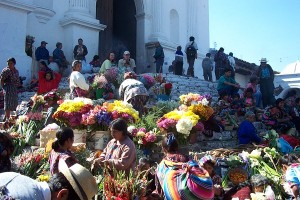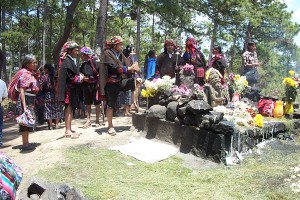Chichi Stories
This is a story dictated to Saq’ Be’ directly from Mayan Ajq’ij Manuel Pan Ju Lux concerning the history and traditions of his home town of Chichicastenango in the Homelands of Guatemala
The story of the Church of Santo Thomas in Chichicastenango, Guatemala; Pascual Abaj; the story of the town of Chichicastenango and the Cofradia
As told by Manuel Pan Ju Lux
Translated from Spanish to English by Saq’ Be’
Church of Santo Thomas
 The church bell is more than 500 years old and is made of gold. The Church of Santo Thomas is different from others in Guatemala. There are twenty steps that lead to the entrance of the church. The twenty steps signify the twenty days of the Mayan Calendar. Starting with the first step leading out of the church is the Ajaw (nawal/spirit/energy) Bat’z (the first of the 20 signs of the Mayan calendar) towards the last step, Ajaw Tz’i (the last of the 20 signs of the Mayan Calendar). The ancient ones left these steps here. It is a Catholic church at the same time it is a Mayan church. Why? Because before the Spanish invasion, where there is now an altar, there was a Mayan altar, where the ancestors would celebrate their ceremonies for the dead ones. In the middle of the church, where there was another altar, this one was to remember the principles of the town. At the entrance of the church was another altar to remember the entire town. It was there that the elders would perform ceremonies to ask for whatever it was they wanted. When the Spaniards came, they wanted to do away with these altars. The Ajq’ij (Mayan spiritual guides) and the principles said that this was a Mayan church as well as a Catholic church. That is why nowadays we still burn incense outside and inside the church.
The church bell is more than 500 years old and is made of gold. The Church of Santo Thomas is different from others in Guatemala. There are twenty steps that lead to the entrance of the church. The twenty steps signify the twenty days of the Mayan Calendar. Starting with the first step leading out of the church is the Ajaw (nawal/spirit/energy) Bat’z (the first of the 20 signs of the Mayan calendar) towards the last step, Ajaw Tz’i (the last of the 20 signs of the Mayan Calendar). The ancient ones left these steps here. It is a Catholic church at the same time it is a Mayan church. Why? Because before the Spanish invasion, where there is now an altar, there was a Mayan altar, where the ancestors would celebrate their ceremonies for the dead ones. In the middle of the church, where there was another altar, this one was to remember the principles of the town. At the entrance of the church was another altar to remember the entire town. It was there that the elders would perform ceremonies to ask for whatever it was they wanted. When the Spaniards came, they wanted to do away with these altars. The Ajq’ij (Mayan spiritual guides) and the principles said that this was a Mayan church as well as a Catholic church. That is why nowadays we still burn incense outside and inside the church.
The Evangelical people want to do away with this church as do the Catholic people. They do not like it because the Ajq’ij comes to perform ceremonies, to burn candles for the dead ones, to remember all the years. For example, the Catholic priests do not like it when they are performing a mass and the Ajq’ij also come to perform their ceremonies. But these ceremonies have been happening since long before the time the Spaniards arrived.
Nearby there is also a “flying pole” where there used to be a cemetery. Recently they have found bones that are a thousand years old. So the Ajq’ij are also doing ceremonies there.
Pascual Abaj
 According to my elders, the people that made this church had the force. It was made by important people. When the elders began [the work] they searched for people [to build the church]. The church is made out of adobe. They started to bring the adobe to build the church, but [whenever they started to build] it would always come down on them. Some of the people would say this was happening because of a lack of ceremonies. Others would say “We’ve done ceremonies, what else is missing?” The elders would say, “You know that, in this place, where there are three altars there were the nawales (spirits) of the altars and they do not want to be removed. This is why the church can not be built.” A big, heavy man would come here with the principals saying his name was Pascual. They would say “he must have a Mayan name.”
According to my elders, the people that made this church had the force. It was made by important people. When the elders began [the work] they searched for people [to build the church]. The church is made out of adobe. They started to bring the adobe to build the church, but [whenever they started to build] it would always come down on them. Some of the people would say this was happening because of a lack of ceremonies. Others would say “We’ve done ceremonies, what else is missing?” The elders would say, “You know that, in this place, where there are three altars there were the nawales (spirits) of the altars and they do not want to be removed. This is why the church can not be built.” A big, heavy man would come here with the principals saying his name was Pascual. They would say “he must have a Mayan name.”
Pascual went to speak with the principles and told them that he knew the church could not be built – but if they left it up to him, the church would be built. So they left it in Pascual’s hands. He then started, with others working with him.
The principles did not know who this man Pascual was. They say that he would finish his job and walk on the path towards the current site of “Pascual Abaj (located a short walk from the church)” and then he would disappear. He would also be able to do a lot of work; he would be able to lift things that would be too heavy for anybody else to do. So the principles would say “Well, what is he? Is he human? Could he be something else?” One day, they said “let’s find out who this man is; he is a man of value.” So, they followed him on the path. He would disappear. “Where is it that he lives? Where is his home and where is his family?? they would ask. In those times, the path to Pascual Abaj was more lush, with more trees around, so they could not find his house.
One day they followed him to exactly where he would disappear and right there was a stone. The principles then went back to tell the rest of the people that Pascual was converted into a stone. Once the church was finished, Pascual never returned to being a human. From then on, the elders say that the stone would be called “Pascual Abaj” (Abaj means stone in Quiche). Ever since then, elders and others have been doing ceremonies at that site.
History of Chichicastenango
Chichicastenango is made up of 76 communities with more than 120,000 inhabitants, 99 percent of which are Mayan. The language spoken is Quiche. During the Spanish invasion, the Spaniards wanted to do away with our traditions. The ancestors had “Camawuiles” – the images of some Ajaw made of jade. The Spaniards told them these idols needed to be done away with, that they needed to be thrown out. Well, the Spaniards did not destroy them; they took them back with them. In exchange, they brought back the images of saints for them. “Your idols are the devil,” they would say, “here our images are from Jesus.” Some elders refused to accept this and said “This is not ours.” These elders died because of saying this.
Others began to say “We need to accept these, but what do we do?” Along with the Spaniards came the priests. In the Mayan spirituality, there is a baptism, only it is mentioned differently. The priests would ask the Indigenous if they had been baptized. Then the priests and the Spaniards would say, “The ones that get baptized with water will be allowed to live and those that do not [get baptized with water] will have to die.” The elders say that the priests brought the cross and bible with them in the right hand and a sword in the left hand. Those that did not receive the baptism would be killed. Then the Spaniards said, “Those that accept these images will be allowed to live, those that do not will be killed.” They said the ceremonies are ‘devil work’ (‘brujeria’), and that they can no longer be performed. “You must now do processions now, go to church, go to the priest in mass.” The elders didn’t know what to do. They had to accept a strategy.
Saint Thomas is the patron (jefe) of Chichicastenango. Here, we have the image of Saint Thomas, this we left in place of the carrier of the day. Underneath [Saint Thomas] the image was marked ‘Job Tzi’kin (the day carrier for Chichicastenango). This was to hide our culture, our traditions. When the Spaniards would come around and ask where Saint Thomas was, the people would reply: “Here he is.” The Spaniards would ask, “What have you done with him?” The people would respond, “Did processions, went to mass.” In reality they would do ceremonies with these images knowing that they were really honoring the Nawales.
This kept happening throughout the years, this is how our traditions were preserved, our culture, with these images.
The Spaniards formed the Cofradias. You can keep your customs, they would say. But come to these images, come to these festivities. They did not like seeing ceremonies being done. If they saw any elder performing any ceremonies, they would kill them, so they had to go to these festivities. We accepted these images.
“We must do ceremonies,” the elders would say. Sure enough, even though they were forced to accept these ways, they also did not stop participating in their own ceremonies. So again, when the Spaniards would come around and ask what they were doing, the people would tell them what they wanted to hear. “We are worshipping these images.” The Spaniards would say, “Well done!” Meanwhile, they had just finished their own ceremonies. This is how they had to preserve a lot of the richness of the Mayan spirituality. A lot of people died in those times, especially many Ajq’ij.
In the Cofradia some Ajq’ij took part in this and accepting the images so that our spirituality would not die. This way our spirituality would be disguised. They felt as though this was not enough. “There are twenty carriers [in Mayan spirituality], one for each day. We have to worship them as well. We will ask for twenty saint images. Each one will hold a corner for each of the twenty days.” They would perform ceremonies on special days, they would light candles for certain images (saints), but they would know that underneath the images were the signs of the days.
So this came with us and now this culture is accepted. It is like inside the Mayan there are two cultures living, the Mayan and the ‘Roman’, we’ll call it. It is a tradition. Every ceremony that is performed, the Ajq’ij needs to go to these images. Why with the images? The elders say that it is because of the images that we now still have our tradition. If it wasn’t for the images and the Cofradia, we would no longer have our tradition.
In each community, there is a principle that is directed by the community. The principles of the communities select a principle for the town. He is in charge of finding the first group of Cofradias (Cofradias consist of six men and six women). When there is a problem in the community, this is the group the people would go to. They are the authority of the town, like a judge. They are the final word. They seek for the rest of the Cofradias. They perform ceremonies. For thirty years, a lot of people wanted to play this important role, to maintain the tradition.
Since there is a lot of Evangelic influence nowadays, a lot of the tradition has been lost. So the people do not want to take part in a Cofradia. To do so would mean that they would have to practice Mayan spirituality, and that they would have to be a part of the principles of the community for the town. They are Evangelist people that do not want to practice Mayan spirituality. Instead, they want to do away with this.
A Cofradia consists of six men and six women. They need to be husbands and wives. The men play the marimba, the drum and make preparations for activities. The women make the atole (a drink made from corn) and prepare the alcohol. They take out the images on the procession.
I realize that if the Cofradia ends, the Mayan Spirituality will be affected. There are a lot of Evangelist churches and radios. Myself and others are trying to organize the elders so that there are more activities happening. For example, a radio show with talks about medicinal herbs, about the sacred Mayan calendar, and we could speak in our own language (Quiche). We know that this is not a traditional part of our culture, but thanks to this we still have our culture. In Chichicastenango, people want to do away with the culture and the traditional language. Fortunately, there are others that do want it around. We want to bring together elders with the youth, so they know about the tradition. But what to do to rescue our tradition.
Right now there is only one Mayan program broadcast on a Catholic radio station. They charge the Indigenous Q400 (approx. $55 US) for a half hour. They (Catholic) too now want to do away with our culture. It would be good to get donations for a frequency to have more Mayan programs. We could talk about:
- Tradition
- Education
- Workshops with the Ancestors
- Ancestral Teachings
- Music
The elders can not participate now because they do not have money.
- Manuel Pan Ju Lux – Young Mayan Ajq’ij - September 8, 2003
- Chichi Stories - August 26, 2003


